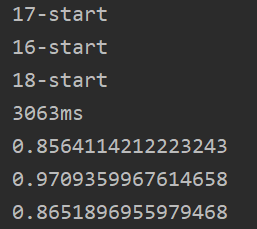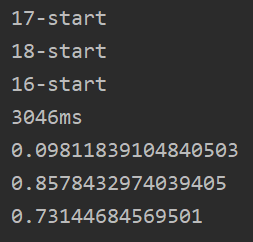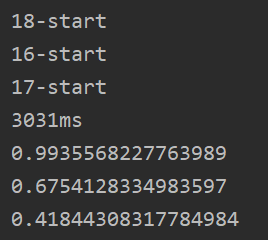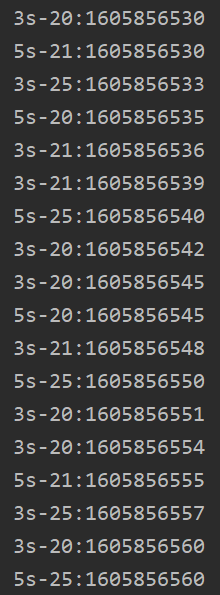SpringBoot中的异步操作与线程池
线程池类型
Java通过 java.util.concurrent.Executors 的静态方法提供五种线程池
- newCachedThreadPool 创建一个可缓存线程池,如果线程池长度超过处理需要,可灵活回收空闲线程,若无可回收,则新建线程。
- newFixedThreadPool 创建一个定长线程池,可控制线程最大并发数,超出的线程会在队列中等待。
- newScheduledThreadPool 创建一个定长线程池,支持定时及周期性任务执行。
- newSingleThreadExecutor 创建一个单线程化的线程池,它只会用唯一的工作线程来执行任务,保证所有任务按照指定顺序(FIFO, LIFO, 优先级)执行。
- newWorkStealingPool 这是java8新增的线程池类型。创建一个含有足够多线程的线程池,来维持相应的并行级别,它会通过工作窃取的方式,使得多核的CPU不会闲置,总会有活着的线程让CPU去运行。
五种线程池的底层实现
- ThreadPoolExecutor 是CachedThreadPool、FixedThreadPool、SingleThreadExecutor、ScheduledThreadPool 这四种类型线程池的底层实现
- ForkJoinPool (java7已有) 是WorkStealingPool线程池的底层实现
使用线程池的优点
- 重用存在的线程,减少对象创建、消亡的开销,性能佳。
- 可有效控制最大并发线程数,提高系统资源的使用率,同时避免过多资源竞争,避免堵塞。
- 提供定时执行、定期执行、单线程、并发数控制等功能。
如何在SpringBoot中优雅的使用线程池
注册线程池
在config目录下创建 AsyncConfig 配置类,在配置类中定义线程池
package com.example.async_demo.config;
import org.springframework.context.annotation.Bean;
import org.springframework.context.annotation.Configuration;
import org.springframework.context.annotation.Lazy;
import org.springframework.scheduling.annotation.EnableAsync;
import org.springframework.scheduling.annotation.EnableScheduling;
import org.springframework.scheduling.annotation.SchedulingConfigurer;
import org.springframework.scheduling.concurrent.ThreadPoolTaskExecutor;
import org.springframework.scheduling.config.ScheduledTaskRegistrar;
import java.util.concurrent.ExecutorService;
import java.util.concurrent.Executors;
@Configuration
@EnableAsync
@EnableScheduling
public class AsyncConfig implements SchedulingConfigurer {
//第一种线程池定义方式,可代替CachedThreadPool、FixedThreadPool、SingleThreadExecutor这三种
// Spring线程池
@Lazy //线程池懒加载
@Bean(name="threadPoolTaskExecutor",destroyMethod="shutdown") //name为线程池名称,destroyMethod="shutdown"在spring bean回收后释放资源
public ThreadPoolTaskExecutor threadPoolTaskExecutor() {
//封装的是原生的ThreadPoolExecutor类型线程池
ThreadPoolTaskExecutor executor = new ThreadPoolTaskExecutor();
//核心线程数(获取硬件):线程池创建时候初始化的线程数
int corePoolSize = Runtime.getRuntime().availableProcessors();
System.out.println(corePoolSize);
executor.setCorePoolSize(corePoolSize);
//最大线程数+5:线程池最大的线程数,只有在缓冲队列满了之后才会申请超过核心线程数的线程
executor.setMaxPoolSize(corePoolSize+5);
//缓冲队列500:用来缓冲执行任务的队列
executor.setQueueCapacity(500);
//允许线程的空闲时间60秒:当超过了核心线程出之外的线程在空闲时间到达之后会被销毁
executor.setKeepAliveSeconds(60);
//线程池名的前缀:设置好了之后可以方便我们定位处理任务所在的线程池
executor.setThreadNamePrefix("MyAsync-");
executor.initialize();
return executor;
}
//第二种线程池定义方式,使用的是WorkStealingPool
//java8 抢占式线程池
@Lazy
@Bean(name="workStealingPool",destroyMethod="shutdown")
public ExecutorService workStealingPool(){
ExecutorService executorService = Executors.newWorkStealingPool();
return executorService;
}
//第三种线程池定义方式,为周期任务线程池
//周期任务线程池
@Lazy
@Bean(name="scheduledThreadPool",destroyMethod="shutdown")
public ExecutorService scheduledThreadPool() {
return Executors.newScheduledThreadPool(3);
}
@Override
public void configureTasks(ScheduledTaskRegistrar scheduledTaskRegistrar) {
scheduledTaskRegistrar.setScheduler(scheduledThreadPool());
}
}
我在上述案例代码中定义了三种类型的线程池
- 第一种是ThreadPoolTaskExecutor线程池,他是Spring中的 org.springframework.scheduling.concurrent.ThreadPoolTaskExecutor 线程池,
底层是对 java.util.concurrent.ThreadPoolExecutor 的封装,综合了CachedThreadPool、FixedThreadPool、SingleThreadExecutor这三种线程池的优点; - 第二种是java8新增的 workStealingPool 线程池。第一种和第二种使用时可以在配置类上使用@EnableAsync注解,这样就能优雅的使用@Async注解方法来实现线程run逻辑了;
- 第三种是ScheduledThreadPool线程池,不过在Spring中使用需要配置类实现SchedulingConfigurer接口,重写configureTasks方法。在配置类上使用
@EnableScheduling注解,就可以优雅的使用@Scheduled注解方法来实现周期逻辑了
使用线程池
对第一种和第二种线程池在service中实现线程run的逻辑
package com.example.async_demo.service;
import org.springframework.scheduling.annotation.Async;
import org.springframework.scheduling.annotation.AsyncResult;
import org.springframework.stereotype.Service;
import java.util.concurrent.CompletableFuture;
import java.util.concurrent.Future;
@Service
public class AsyncService {
//使用名为threadPoolTaskExecutor的线程池,返回Future
@Async("threadPoolTaskExecutor")
public Future<Double> service1(){
double result = getRand(3000);
return AsyncResult.forValue(result);
}
//使用名为threadPoolTaskExecutor的线程池,返回CompletableFuture
@Async("threadPoolTaskExecutor")
public CompletableFuture<Double> service2(){
double result = getRand(3000);
return CompletableFuture.completedFuture(result);
}
//使用名为workStealingPool的线程池,返回CompletableFuture
@Async("workStealingPool")
public CompletableFuture<Double> service3(){
double result = getRand(3000);
return CompletableFuture.completedFuture(result);
}
private double getRand(long sleep){
System.out.println(Thread.currentThread().getId()+"-start");
try {
Thread.sleep(sleep);
} catch (InterruptedException e) {
e.printStackTrace();
}
double result = Math.random();//方法返回的结果
return result;
}
}
测试第一种和第二种线程池
@SpringBootTest
class AsyncDemoApplicationTests {
@Autowired
private AsyncService asyncService;
@Test
void test1() throws ExecutionException, InterruptedException {
long start = System.currentTimeMillis();
Future<Double> result1 = asyncService.service1();
Future<Double> result2 = asyncService.service1();
Future<Double> result3 = asyncService.service1();
//让主线程等待子线程结束之后才能继续运行
while (!(result1.isDone()&&result2.isDone()&&result3.isDone())){
Thread.sleep(500);
}
long end = System.currentTimeMillis();
System.out.println(end-start+"ms");
System.out.println(result1.get());
System.out.println(result2.get());
System.out.println(result3.get());
}
@Test
void test2() throws ExecutionException, InterruptedException {
long start = System.currentTimeMillis();
CompletableFuture<Double> result1 = asyncService.service2();
CompletableFuture<Double> result2 = asyncService.service2();
CompletableFuture<Double> result3 = asyncService.service2();
//join() 的作用:让主线程等待子线程结束之后才能继续运行
CompletableFuture.allOf(result1,result2,result3).join();
long end = System.currentTimeMillis();
System.out.println(end-start+"ms");
System.out.println(result1.get());
System.out.println(result2.get());
System.out.println(result3.get());
}
@Test
void test3() throws ExecutionException, InterruptedException {
long start = System.currentTimeMillis();
CompletableFuture<Double> result1 = asyncService.service3();
CompletableFuture<Double> result2 = asyncService.service3();
CompletableFuture<Double> result3 = asyncService.service3();
//join() 的作用:让主线程等待子线程结束之后才能继续运行
CompletableFuture.allOf(result1,result2,result3).join();
long end = System.currentTimeMillis();
System.out.println(end-start+"ms");
System.out.println(result1.get());
System.out.println(result2.get());
System.out.println(result3.get());
}
}
test1测试结果

test2测试结果

test3测试结果

通过测试发现Future返回类型不适合主线等待多个子线程全部完成的操作,
因为需要用到while循环去阻塞主线程,而CompletableFuture可以通过CompletableFuture.allOf(cf1,cf2,cf3).join()
去完成这个操作,所以推荐使用CompletableFuture作为返回类型
注意:@Async注解的方法不能在本类中被调用,只能在其他类中调用,如Controller类
对第三种线程池在service中实现线程的逻辑
package com.example.async_demo.service;
import org.springframework.scheduling.annotation.Scheduled;
import org.springframework.stereotype.Service;
@Service
public class AsyncService {
//cron表达式 每5秒执行一次
//@Scheduled(cron = "*/5 * * * * ?")
@Scheduled(cron = "${cron.sec5}") //表达式写在application.yml文件中,则以这种方式取出。
public void service4(){
System.out.println("5s-"+Thread.currentThread().getId()+":"+System.currentTimeMillis()/1000);
}
//cron表达式 每3秒执行一次
@Scheduled(cron = "${cron.sec3}")
public void service5(){
System.out.println("3s-"+Thread.currentThread().getId()+":"+System.currentTimeMillis()/1000);
}
}
application.yml 文件
cron:
sec5: '*/5 * * * * ?'
sec3: '*/3 * * * * ?'
周期任务测试结果(启动Application类)

通过测试结果可发现两个周期任务使用了三个线程,
线程id分别是20、21、25。两个周期任务分别以3s和5s执行一次,
但不固定在某个线程中执行,而是哪个线程空闲则使用哪个线程
注意:若不为周期任务配置线程池,只使用@EnableScheduling和@Scheduled注解的话,
则所有周期任务共用一个子线程,若出现下一个周期开始上一个周期任务还没结束的情况,
则线程阻塞,直到前一个任务完成
CRON表达式
- cron表达式是定义任务周期的一种表达式
- 这里不多介绍,可以参考这篇博客